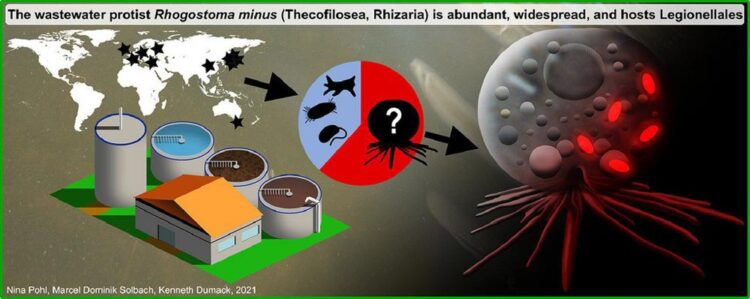Potential parasites in the most common amoeba in wastewater treatment plants

Rhogostoma minus is the most common amoeba in wastewater treatment plants worldwide. It can serve as a host for bacteria of the order Legionellales, which includes pathogens such as Legionella pneumophila, the cause of Legionnaires’ disease.
Researchers from Professor Michael Bonkowski’s working group at the University of Cologne’s Institute of Zoology have found that Rhogostoma minus is the most common amoeba in wastewater treatment plants worldwide and also serves as a host for Legionellales. The Legionellales identified in the amoebae were previously undescribed, so it is not clear whether these amoebae can cause disease in humans.
A recent article by the same research group (see link below) had already shown that Rhogostoma also hosts the dangerous Legionella bacteria, whose species cause Legionnaires’ disease. ‘This strongly suggests that these amoebae may be potential hosts for human pathogens,’ said leading researcher of the study Nina Pohl. Study leader Dr Kenneth Dumack added, ‘These connections and insights into the role of amoebae in wastewater treatment plants as breeding grounds for pathogenic bacteria may help to clarify infection pathways in the future to ultimately prevent further contagions.’
Nina Pohl, Marcel Dominik Solbach, and Kenneth Dumack have published the results of their article ‘The wastewater protist Rhogostoma minus (Thecofilosea, Rhizaria) is abundant, widespread, and hosts Legionellales’ in the journal Water Research.
Amoebae belong to the so-called complex unicellular organisms. They serve as hosts for the bacterial order Legionellales and are thus possible vectors of Legionnaires’ disease. Yet little is known about them so far. Although wastewater treatment plants obviously function well, to date a large proportion of the microorganisms within them are poorly understood. In addition to the useful water purifying microorganisms, parasites are also washed into the wastewater treatment plants via sewage. It is still unclear how they spread and when this leads to disease outbreaks. It is therefore not surprising that in the past there have been repeated outbreaks of disease around wastewater treatment plants and contaminated drinking water.
The bacteria of the order Legionellales can cause, among other things, the so-called Legionnaires’ disease. As soon as the bacteria enter the lungs through aerosols or droplets, they can trigger pneumonia, which can sometimes be fatal. To date, however, it is unclear when these Legionellales become prevalent in wastewater treatment plants and what causes them to proliferate. This question, as well as whether the bacteria found are actually dangerous to humans, will have to be clarified by future research.
Link (Abstract):
https://www.sciencedirect.com/science/article/abs/pii/S0043135421007612
Upon request, the authors are happy to share the entire article.
Media Contact:
Dr Kenneth Dumack
Institute of Zoology
Terrestrian Ecology (Working group of Prof. Bonkowski)
+49 221 470 8242
kenneth.dumack@uni-koeln.de
Press and Communications Team:
Robert Hahn
+49 221 470 2396
r.hahn@verw.uni-koeln.de
Media Contact
All latest news from the category: Ecology, The Environment and Conservation
This complex theme deals primarily with interactions between organisms and the environmental factors that impact them, but to a greater extent between individual inanimate environmental factors.
innovations-report offers informative reports and articles on topics such as climate protection, landscape conservation, ecological systems, wildlife and nature parks and ecosystem efficiency and balance.
Newest articles

Sea slugs inspire highly stretchable biomedical sensor
USC Viterbi School of Engineering researcher Hangbo Zhao presents findings on highly stretchable and customizable microneedles for application in fields including neuroscience, tissue engineering, and wearable bioelectronics. The revolution in…

Twisting and binding matter waves with photons in a cavity
Precisely measuring the energy states of individual atoms has been a historical challenge for physicists due to atomic recoil. When an atom interacts with a photon, the atom “recoils” in…

Nanotubes, nanoparticles, and antibodies detect tiny amounts of fentanyl
New sensor is six orders of magnitude more sensitive than the next best thing. A research team at Pitt led by Alexander Star, a chemistry professor in the Kenneth P. Dietrich…





















